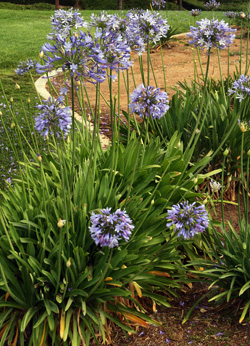Understanding the Art of Agapanthus Treatment: Important Steps for Healthy And Balanced Growth and Vibrant Blossoms
In the world of cultivation, the growing of agapanthus stands as a gratifying undertaking for those that look for to nurture these stylish blooming plants. From choosing the ideal range to grasping trimming methods, the journey towards growing growing agapanthus plants is diverse and holds the key to opening the full possibility of these herb treasures.

Choosing the Right Agapanthus Selection

When picking the ideal Agapanthus selection for your garden, consider aspects such as climate viability, flower shade, and growth behavior. In addition, think about the environment in your area to make certain the Agapanthus range you select can grow in your specific conditions. Understanding the development routine of various Agapanthus varieties is crucial for correct positioning within your garden.
Perfect Planting Conditions
Considering the optimum environmental requirements is necessary for successful Agapanthus growing. Agapanthus flourishes in well-draining soil with a slightly acidic to neutral pH degree. When growing, select a location that gets full sunshine to partial shade. In hotter environments, supplying some afternoon color can protect against scorching of the leaves. Agapanthus plants are sensitive to chilly temperatures and need to be shielded from frost during winter season.
To ensure healthy growth and vivid blooms, plant Agapanthus light bulbs at a depth of concerning 2-4 inches and area them 8-12 inches apart. Adding organic issue, such as garden compost, to the dirt can boost drain and fertility, promoting durable origin development. Mulching around the base of the plants aids retain dampness and subdues weed growth. Regular watering is essential, particularly during the growing season, to keep the soil continually wet but not waterlogged.
Watering and Feeding Tips
Maintaining proper dampness degrees and giving necessary nutrients are key components in the treatment routine for Agapanthus plants. When it involves watering Agapanthus, it is essential to strike an equilibrium. These plants prefer regularly wet dirt however are at risk to root rot if overwatered. During the expanding season, water deeply once a week, making sure the soil is well-draining to avoid waterlogging. In hotter environments or throughout periods of drought, even more frequent watering might be necessary to maintain the dirt uniformly moist. Nonetheless, minimize watering in the winter season to avoid waterlogged problems.
Feeding Agapanthus is crucial for promoting healthy and balanced growth and respected blossoms. Apply a balanced plant food, such as a 10-10-10 formula, in the early springtime as new development arises. By adhering to these watering and fertilizing tips, you can ensure your Agapanthus plants grow and generate vibrant, resilient flowers.
Trimming Techniques for Agapanthus
Pruning Agapanthus plants at the suitable times and with proper strategies is important for keeping their health and wellness and advertising optimal growth and flowering. The ideal time to trim Agapanthus remains in late winter season or very early springtime prior to new development arises. Begin by getting rid of any dead or yellowing fallen leaves near the base of the plant. Cut them as close to the ground as feasible without damaging the emerging shoots.
For flowered stems, wait until the blooms have actually perished and after that cut them back to the base. This not only cleans up the plant's look however additionally urges the growth of new blossom buds. Deadheading spent flowers can likewise redirect the plant's energy right into generating even more blooms instead than setting seeds. Nonetheless, if you wish to gather seeds for breeding, leave some blossoms to mature and completely dry on the plant.
Remember to utilize clean, sharp tools to make accurate cuts and lower the danger of presenting conditions. Agapanthus. Routine trimming will aid maintain your Agapanthus looking healthy and neat while making sure an abundant display of lovely blooms
Dealing With Typical Insects and Diseases
After ensuring correct trimming strategies for Agapanthus, it is necessary to address common pests and illness that can webpage impact the health and wellness and vitality of these plants. Agapanthus plants are generally hardy however can still succumb to particular issues. One typical bug that influences Agapanthus is the Agapanthus gall midget. This little, orange fly lays its eggs in the foliage, causing altered growth and flower buds that fall short to open up. To combat this insect, prune and ruin any kind click reference of damaged plant parts and consider using insecticidal soap.
Additionally, Agapanthus plants can endure from origin rot if they are planted in poorly draining pipes soil. By being attentive and taking timely activity against pests and diseases, you can help your Agapanthus plants prosper and create dynamic blossoms. Agapanthus.

Final Thought
Finally, understanding the art of agapanthus treatment includes picking the ideal selection, supplying perfect planting conditions, proper watering and fertilizing, proper trimming methods, and dealing with typical bugs and diseases. By following these important steps, you can make certain healthy growth and dynamic blooms for your agapanthus plants. Remember to on a regular basis keep track of and maintain your plants to promote their total health and durability.
To ensure healthy and balanced development and dynamic flowers, plant Agapanthus light bulbs at a depth of regarding 2-4 inches and space them 8-12 inches apart. By following these watering and fertilizing suggestions, you can guarantee your Agapanthus plants grow and produce vivid, long-lasting flowers.
One usual parasite that affects Agapanthus is the Agapanthus gall midget. Additionally, Agapanthus plants can experience from origin rot if they are grown in improperly have a peek at this site draining pipes soil. By complying with these vital steps, you can guarantee healthy and balanced development and lively blooms for your agapanthus plants.